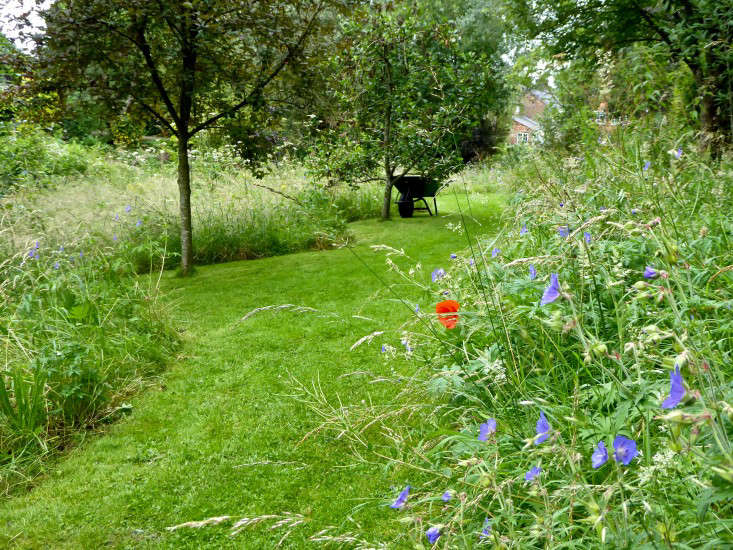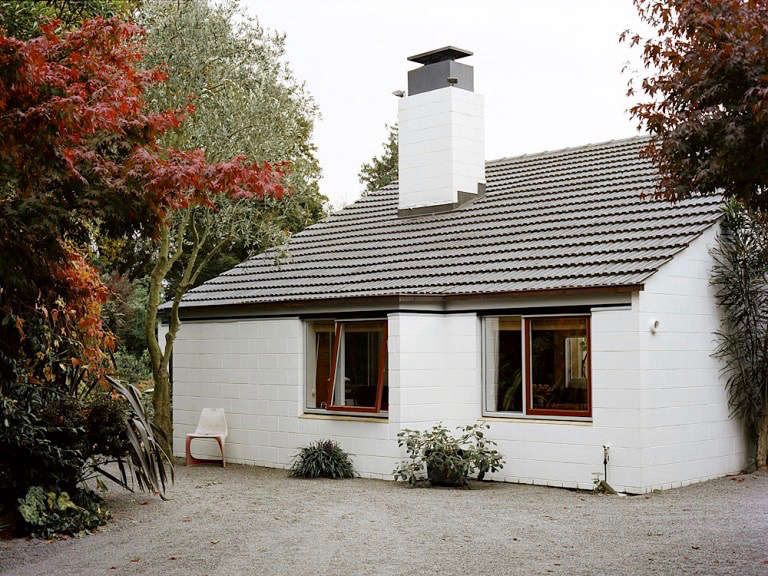Of the many Arts and Crafts gardens around the hills of the Cotswolds and the Malverns in England, the outdoor arrangement at Kelmscott Manor is the most tangible: a simple walled rectangle, marking a set of enclosures surrounding an Elizabethan mini manor. Rented by the designer and thinker William Morris during his lifetime (and later bought by the family), receipts show that plenty of plants and trees were put in before Morris’s daughter, May, bequeathed the property to Oxford University in the 1930s, with the stipulation that there be “no modernization.” This saved Kelmscott’s essential character—and almost destroyed it. By the time the Society of Antiquaries took over in the 1960s, the stone house (and stone roof) was resting on rotted beams and soft earth, weeks away from imploding.
A recent £6-million investment has allowed the manor to sing once more, with original Morris and Co. furniture and vibrant hand-blocked William Morris papers adorning the walls as they used to. Curious to visit before any further cash injections move the focus to the garden, we set off toward Lechlade (about two hours from London). The weather report was straight out of William Morris’s poem ‘Kelmscott Crab Apples’: “Fair was the spring but amidst his greening/ grey were the days of the hidden sun.”
Photography by Britt Willoughby Dyer for Gardenista.

“The garden is quite unaffected and very pleasant, and looks in fact as though it were a part of the house; at least the clothes of it,” wrote William Morris in 1871, adding: “which I think ought to be the aim of the layer-out of a garden.” When Morris came to the village of Kelmscott, Oxfordshire, he was a man of strong opinions on many subjects besides gardens, an eminent Victorian who rebelled against the excesses of the Victorian age. He was also frantically busy: In addition to running the home furnishings company for which he is most famous today, thanks to his time at Kelmscott he nurtured other interests like protecting old buildings, running a printing press, embroidering, designing patterns for papers and textiles, exploring natural dyes, and writing best-selling poetry. Polymath does not even cover it: “If a chap can’t compose an epic poem while he’s weaving tapestry,” noted Morris, “he’ll never do any good at all.”

William Morris loved Kelmscott so much that he used the name for the Kelmscott Press, and renamed his rented London house, Kelmscott House. Both places were connected by the meandering river Thames. He liked the idea of traveling by river from one house to the other, which he did (just the once; it took a week) with his wife Jane and two children, Jenny and May. The willows that fringe the edges of the Thames were clearly an inspiration—the pattern Willow Boughs continues to be a best-seller—while other patterns, such as Kennet, Wandle and Lodden were named after tributaries of the Thames (and are still in production).
Morris’s housemate, the Pre-Raphaelite Brotherhood co-founder Dante Gabriel Rossetti, initially loved Kelmscott too, especially during the first summer when Morris removed himself to Iceland. Rossetti’s decades-long affair with Morris’ wife left a strong legacy in the Pre-Raphaelite canon, with his many drawings and paintings of Jane among his best-known work. However, living alone in the cold stone house in winter, surrounded by watery flood meadows, was not so fun and Rossetti’s mental health deteriorated rapidly. He was gone after three years.

Jane Morris, one of the most recognizable of the Pre-Raphaelite “stunners,” was discovered by Morris and Rossetti at a theater in Oxford, where they were painting murals at the Oxford Union. The friends both fell for her, but Rossetti was already married (to the doomed Ophelia model Lizzie Siddal). Jane was a working-class girl from the university city whose father was a stable man and mother was a servant. When she became Mrs Morris, she was a quick study; Kelmscott villagers described her accent as “queenly.” It’s not difficult to see William Morris as a variation on Henry Higgins, with Jane Morris a precursor to Eliza Doolittle. Morris was a committed socialist like the Pygmalion playwright George Bernard Shaw, a longterm family friend.

The Society for the Protection of Ancient Buildings (SPAB) is one of Morris’s many legacies. He was appalled by Victorian “restorations” in which charming and serviceable old buildings were scraped back to remove their patina or replaced entirely, with new-old versions in the pervasive neo-gothic style. Instead of a brutal remodel, Morris saw low-level maintenance as the best way forward, with the advice: “stave off decay with daily care.” This appears to be the ethos of the old gardens around Kelmscott, which besides being made visitor-ready in the 1970s with paths put in places where there were no paths before, have not had a makeover—and neither have they had funds. It’s difficult to resist thinking about how to clothe the garden now (with proper investment), in a way that would appeal to William Morris.
The unwrecked landscape feels unusually personal for a house without residents, and is lovingly maintained by Celia who lives in the village. Under the mulberry tree (dating from the Morris’s time), finely-shaped tulips (Tulipa sylvestris) suddenly appeared a few years ago in grass that was left to grow longer, after decades of waiting under short turf. The patient corms and bulbs of winter aconite and common Muscari have also flourished; all that has been reintroduced here are the less long-lived snakeshead fritillaries, very at home in this damp garden and immortalized in printed patterns for Morris and Co.

Visitors to Kelmscott have long been struck by the outdoor privy, as beautiful and useful as any of the buildings on the estate. Because there are three circles cut into the wooden bench across the back wall, it has been mistaken for a communal convenience but sad to report, it is really just a generously appointed single loo, with a sandbox on either side.

The privy is a short walk from the house, in a densely-planted yard. The tiny walled garden is a glorious micro climate for country plants such as gooseberries and rhubarb, chives, mint and rosemary, hollyhocks and lilac. It was here that Morris watched a thrush stealing an alpine strawberry (Fragaria vesca) which inspired one of his most famous designs, Strawberry Thief.

“Apart from the desire to produce beautiful things, the leading passion of my life has been and is a hatred of modern civilization,” Morris wrote, dismayed over the effects of the Industrial Revolution and capitalism. Conflicted about his own role as a successful businessman, he oversaw every stage of manufacture, learning how to do things from the bottom up, such as dyeing and weaving. It was a way of preserving the old crafts and making these things available to the buying public. He is considered today to be one of the first eco-socialists, believing that social justice and respect for the natural world should go hand in hand.

A short film made by the Society of Antiquaries in the 1970s shows the house architect and chief antiquary discussing its condition (after the final tenants moved out) in clipped tones: “The kitchen had been used for breeding guinea pigs, but it was scarcely even fit for that.”



The front view of the house, featuring a porch and a path flanked by an avenue of standard roses, is generally considered to be the money shot, by visitors to Kelmscott. It might not be the most interesting view, and Morris preferred to use the side door, but it was immortalized in an illustrated frontispiece to one of Morris’s fantasy novels, which was based on Kelmscott and was inspired by its utterly peaceful character. “This is the picture of the old house by the Thames to which the people of this story went,” begins the inscription. “Hereafter follows the book itself which is called News from Nowhere or an Epoch of Rest…”

Love Arts and Crafts style? See also:
- • Chelsea Flower Show 2022: Arts and Crafts Revisited
• Rodmarton: The Last Word in Arts and Crafts Gardens
• Stone and Roses: Asthall Manor in the Cotswolds.














Have a Question or Comment About This Post?
Join the conversation (1)